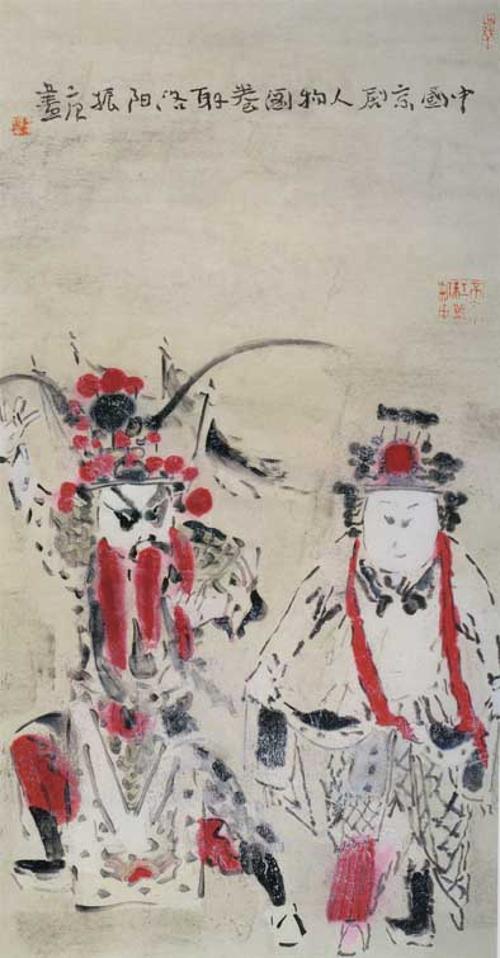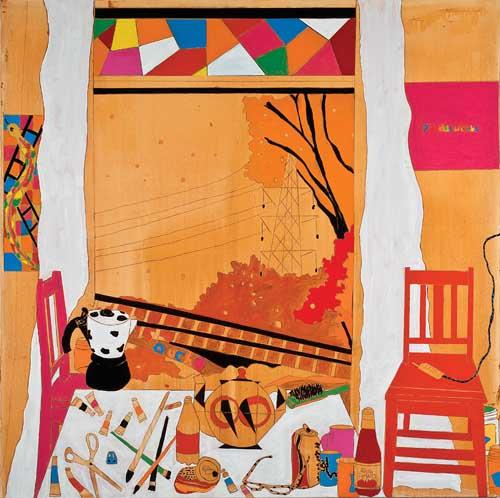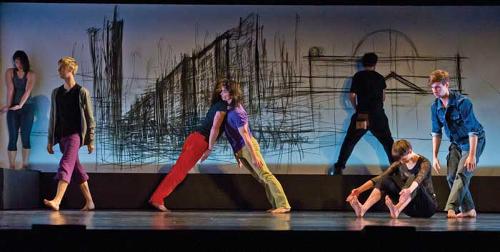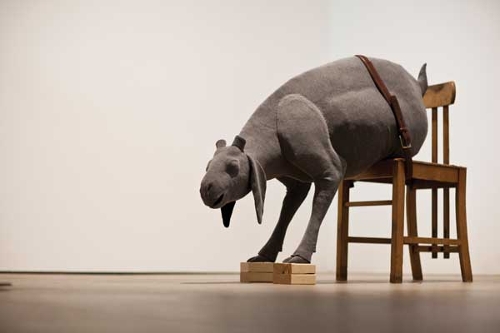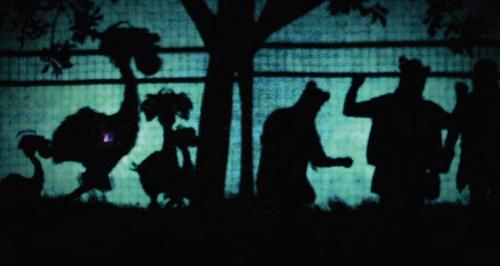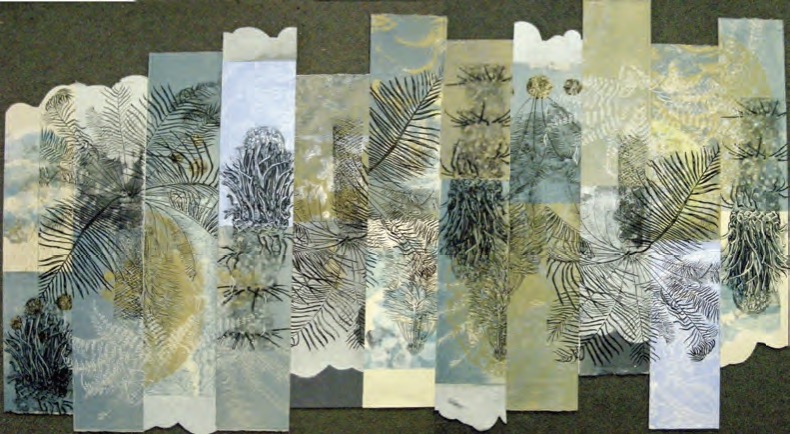
Impending Encounter 24 HR Art, Darwin
9 September - 15 October 2011
TOGART Contemporary Art Award 2011
Chan Contemporary Art Space, Darwin
9 September - 16 October 2011
Impending Encounter was a collaborative art project undertaken by Talitha Kennedy, Catriona Stanton, and Ann Ooms. Their artworks responded to the particular space of 24 HR Northern Territory Centre for Contemporary Art in Darwin. Although the works were disparate in scale, medium and approach, they were united by a common concern with process and materiality. The fragility, impermanence, organic nature and quirkiness of these works were also informed by the artists' experience of living in a tropical environment for an extended period of time.
Straining high across the gallery space Talitha Kennedy’s black leather portico form acted as a protective cocoon or womb, an association emphasised by the umbilical form hanging from the centre of the form down into the gallery space. Little sections of the leather appeared eaten away - recalling the worn forms of green ant-infested leaves and more broadly the constant cyclic processes of decay and regeneration that are a feature of Territory life.
Providing a counterpoint to Kennedy’s work were Catriona Stanton’s synthetic, vertical forms created out of kitchen sink scrubbers threaded onto poles dotted with Christmas lights. These were draped with transparent plastic sheets hung from hooks and suspended from the gallery’s high ceiling. In Stanton’s hands, these everyday materials were transformed into works with a poetic resonance evoking associations with pine-tree forests or delicate veils. These forms also investigated the qualities of light, transparency and impermanence inherent to the synthetic materials selected. Ooms’ wall drawings, based on a series of doodles projected onto the gallery walls and outlined in charcoal, acted to unite the contrasting works of Kennedy and Stanton. Ooms’ evocative images allude to various organic forms such as mould, feathers and mangrove roots. Although dissonant in character, the artworks worked together to create a harmony within the exhibition space and to make the viewer aware of the physical qualities of the gallery as a site for experimental practice.
This exhibition at 24HR Art marks a change in the policy of the gallery away from introducing the work of established contemporary artists and towards a greater focus upon stimulating experimentation and developing the careers of Darwin’s highly talented long-term resident artists.
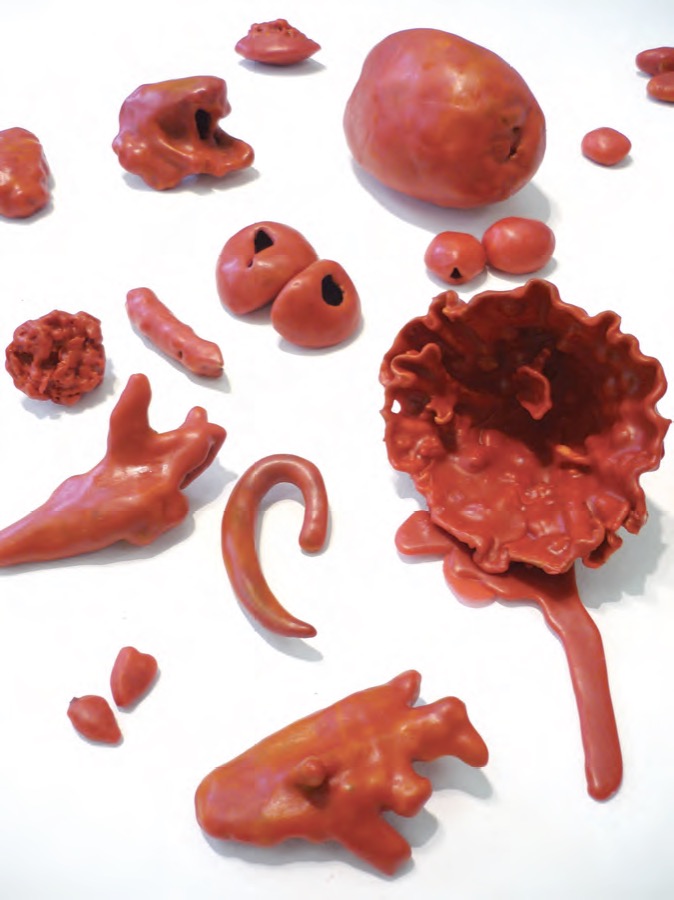
Across town, at the Chan Contemporary Art Space building next to old Parliament House, this year’s Togart Contemporary Art Award was also a testament to the strength, resilience and uniqueness of the Territory’s artists – a community described by Award organiser Felicity Green as "a creative dynamo running on the smell of an oily rag". Now in its fifth year, the Togart Award emerged from a contractual agreement between the Northern Territory Government and the Toga Building Group to spend 1% of their budget on supporting the arts community in the Northern Territory – allowing the catalogue, exhibition expenses and a $15,000 art prize to be supported. This year’s exhibition is the strongest so far, featuring many artists who had not previously been selected including Min Wong and the award-winner 22 year old Indigenous artist Joshua Benson. His painting Skin continues his experimentation with abstract, impasto paintings inspired by crocodile skins.
A unique quality of the Award is its selection of Indigenous and non-Indigenous artworks, a structure that allows for the cross-fertilisation between these two groups to be visible. This is reflected in the print collaboration between Darwin-based artist Rob Brown and Indigenous designer Djon Beasley who worked together to produce Cheeky T-Shirt – depicting a boy wearing a t-shirt illustrated with cheeky dogs.
The range of mediums and approaches in this year’s Award were diverse and dynamic. Pamela Loft’s photograph of a salt lake in the Tanami Desert with the word silence etched into the sand “to articulate without sound or voice the beauty of silence” captures the eerie expanse of this landscape. It provided a dramatic contrast with Therese Ritchie’s portrait of a Japanese couple jumping in the air on Bali’s Jinbaran beach in front of a man taking a photograph with their new Nikon camera.
One of the highlights of the exhibition was Tiger Palpatja’s Piltatinga a painting of a creation story near Nyapri community. But there were also quirky and experimental works such as Marlene Rubuntja’s Pangkerlange (scary monsters), 3D forms made out of recycled grey woolen blankets. Winsome Jobling’s Cycad was also innovative, built up from layer upon layer of cycad images printed onto paper panels with shaped 'cloud form’ edges. Catriona Stanton’s Melt featured a tea-tray stacked with red wax forms that had melted in the heat. These udder-like and sausage forms oozed and spread providing a powerful visual metaphor of the way imported, colonial, domestic traditions metamorphose within a tropical environment.
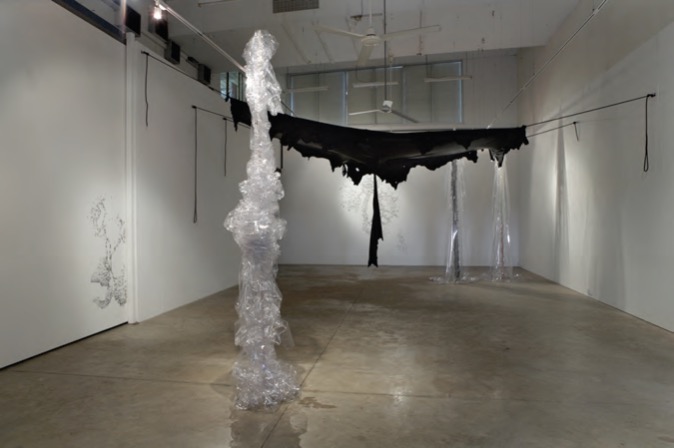
It is exhilarating to see the emergence of another generation of artists committed to the Northern Territory as a place of residence who are producing work that responds to their local environment with sophistication and subtlety. Given the unique aspects of this place and community, it is regrettable that this year’s judging panel and catalogue writers did not include an informed local critic as in previous years (and I say this as an ex-Darwin resident who was on the pre-selection panel and is now based in Canberra). It is, of course important to receive commentary and recognition from nationally renowned arts professionals and critics. But it is also vital that at least one of the judges and essay writers for the catalogue is able to articulate the clear developments in the work of NT artists such as Anna Reynolds, Winsome Jobling, Fiona Gavino and Merran Sierakowski over the last five years – and to comment upon changes in approach. For example, Chayni Henry’s self-portrait in traditional ‘romantic’ Maori costume Millner Mob is a departure from the 'personal narrative' focus of her previous work. It challenges the idea of finding an ‘authentic’ identity through connection with ancestors. Henry states: “I am not going to wear a Korawai (cloak) to get my Moko (facemarking) and move to New Zealand to harass my relatives – largely strangers – to teach me everything they know.”
This year’s Togart Award bears testament to the strength, resilience and dynamism of contemporary artists in the Territory. But in order for the high quality of work found in this year’s Award and in 24 HR Art to continue, it is essential that a larger range of high-quality training and development opportunities are available to emerging arts practitioners in the NT. Now in its fifth year, it is also essential that there is a strong vision for the future of this remarkable Award and that its connections with the local community remain strong.



